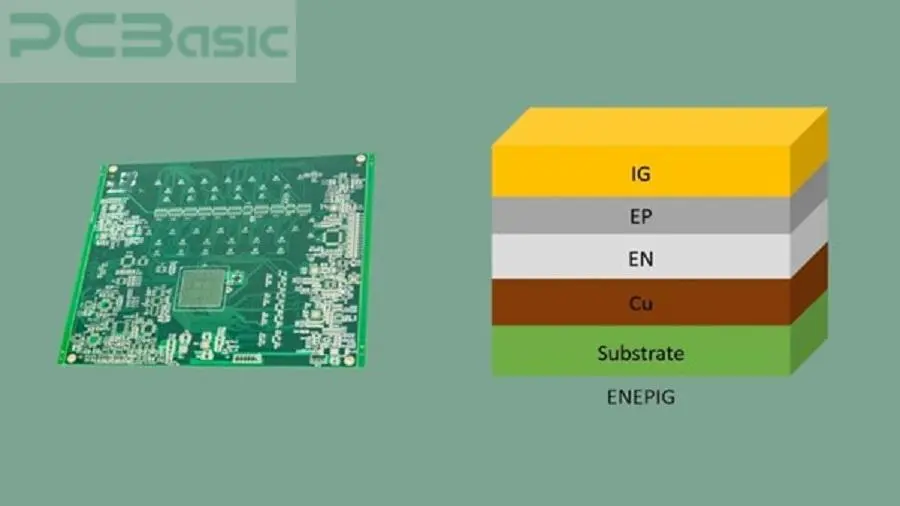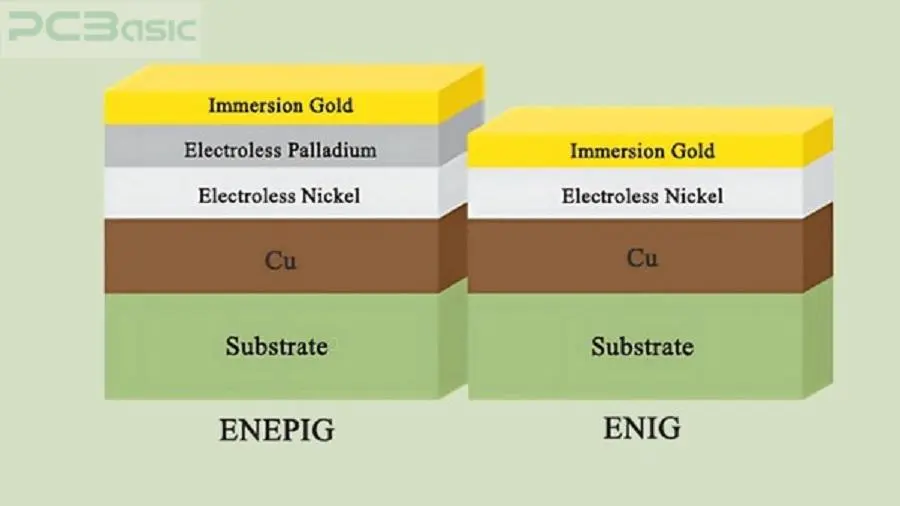Global high-mix volume high-speed Shenzhen PCBA manufacturer

Ru
9:00 -18:00, Mon. - Fri. (GMT+8)
9:00 -12:00, Sat. (GMT+8)
(Except Chinese public holidays)





Global high-mix volume high-speed Shenzhen PCBA manufacturer

Ru
9:00 -18:00, Mon. - Fri. (GMT+8)
9:00 -12:00, Sat. (GMT+8)
(Except Chinese public holidays)





HomePage > Blog > Knowledge Base > ENEPIG | PCB Surface Finish
The backbone of modern electronics is PCBs, which mold and shape the very base of any equipment, be it consumer appliances, medical equipment, or even an aerospace system. Therefore, they cannot be replaced by any other in terms of performance or as far as reliability is concerned. Among the many surface finishes that make the bottom line when judging a PCB's efficiency, ENEPIG (Electroless Nickel, Electroless Palladium, and Immersion Gold), also referred to as nickel palladium gold plating, has been determined to be one of the most efficient and reliable.

Further description of the makeup, how it is constructed, and advantages it has compared to finishes like ENIG (Electroless Nickel Immersion Gold). Whether you are a designer of printed circuit boards or an assembler looking for just that perfect enepig finish on your product, ENEPIG plating makes the fine print make complete sense. Understanding the differences between enepig vs enig (or enig vs enepig) is critical for applications requiring advanced circuit board plating solutions.
The base metal of ENEPIG is provided with excellent corrosion resistance due to an electroless plating by immersion of sequential layers of nickel, palladium, and gold. This kind of surface finishing, known as enepig plating, will offer improved corrosion resistance in comparison with usual finishes but will have excellent soldering capability coupled with good wire-bonding properties. The fundamental principle that applies to the ENEPIG finish is that it forms a thin protective layer.
In this enepig PCB, the layer rests above the copper pads. Therefore, nickel acts as a diffusive barrier for copper. Generally, the layer of palladium is essential because it makes the finish better and provides a good surface for the protection of nickel against corrosion. Quality in the PCB is thus supplied by solderability. The outer layer of a gold mask removes oxidation that may be happening underneath it.

Speaking generally, ENEPIG is relatively easy to plate; the plated layers are chemical reaction products of nickel, palladium, and gold. This characteristic is unique to ENEPIG plating as the electroless process does not require any source of external power. The most important purpose of every material layer is to make a PCB function better.
● Nickel: Electroless deposited as the first layer to act as a diffusion barrier between the copper and stable base on which all the subsequent layers are deposited.
● Palladium: An electroless second layer, it has extremely high corrosion resistance that prevents nickel from degrading further.
● Gold: It has a top finish layer electroplated with gold on the board. This provides resistance against oxidation and ensures that the PCB has high solderability. This property is highly essential if parts are attached.
It is ENEPIG by the combination of the three metals. It is an attractive and versatile enepig finish that can be met with the demands of advanced applications of PCBs, mainly where reliability and performance pose a challenge to many industries.
Let's break down how ENEPIG is made to make it more transparent. Generally speaking, here's the gist of the primary process regarding the coating of ENEPIG:
One of the most crucial pretreatments involves the activation of copper on PCBs because electroless nickel needs excellent adhesion to this. In most instances, the cleaning or etching of copper leaves it perfectly conducive to plating because most contaminants and the oxides present in the copper dissolve.
This process deposits a nickel layer chemically onto the activated copper surface. Soon to become of interest by depth, this nickel layer acts as a basis for further circuit board plating layers to be deposited while preventing the migration of copper, which otherwise would degrade the PCB’s performance with time.
There is the top layer of palladium. It prevents oxidation on the nickel layer; it improves toughness strength and the durability of the finish. Further, it protects the nickel and accommodates the acceptable absorption of a layer of gold at the surface.
The thinnest overlay is that of gold used in the last overlay. It plums itself by immersion. This typically enhances the solderability, which helps match the components during assembly. Besides that, the protective coating will protect against the oxidation of the layers below.
Therefore, as of now, ENEPIG has been well digested in terms of advantages, but, as with everything, it also has its downsides, so let's discuss both.
● Nickel Coating: Protecting layer and protecting coatings layer-anti-oxidation. A nickel layer of this type is deposited within relatively short periods with adequate coverage and protection against oxidation. One of the strengths of ENEPIG is the nickel layer, which offers protection.
● Higher Reliability and Solderability: Such highly reliable industries like aerospace, medical devices, etc., are linked between its parts and PCB since ENEPIG has a gold layer that offers good solderability along with the same.
● Wires' Higher Bonding Capacity: This is very common in wire bonding, wherein wires are made of gold and aluminum. The help of the palladium cap layer is prevented from oxidation, thus promoting mechanical bonding.
● Reduced Contact Resistivity: ENEPIG is a multi-layer material that features no contact resistance; thus, it becomes useful for applications that deliver good high-speed and high-frequency performance. This material is ideal for RF and microwave enepig PCB applications.
● Tangier End: The disadvantage of ENEPIG is that it provides a relatively more expensive comparison to the simple ENIG finishing. An additional step in the form of the layer of palladium incurs a cost for the finish, which thus makes ENEPIG relatively more expensive than ENIG.
● Unpleasant Manufacturing Process: The multi-step application process, in general, ENEPIG, is more precise and takes longer to make a product; hence, it is inherently more complex and longer to manufacture than the majority of other finishes. The manufacturing lead times are added to these.
● Inelastic Supply: It is a very complex and, hence, a very costly process. Not all PCB manufacturers are available for this; it gathers popularity and might have small-run capability on a highly restricted scale.
However, standard ENEPIG performance is largely a function of plating layer thickness. The following outline describes general standard thickness specifications:
Nickel Layer: It consists of closed dimensions between 3-6 microns. This is a background that keeps the copper away.
Palladium Layer: It is of the order 0.05-0.2 microns in thickness. The palladium layer prevents oxidation of nickel and supports wire bonding.
Gold Layer: The gold layer is 0.03 to 0.1 microns in thickness. As fine as it sounds, it carries all the necessary oxidation-proofing and solderability protections.
It is achieved by the desired performance and life of the PCB that supports these specified thicknesses.
ENEPIG is suitable for high-performance and reliability applications. For that reason, it becomes the enepig finish of choice for the following:
ENEPIG is very useful in RF and microwave circuits, with low contact resistance and good durability at high frequency. That makes telecom equipment and data transmitting quite effective.
Medical instruments and aerospace device manufacturing firms need failure tolerance. The area of ENEPIG plating has to be reliable and sturdy. Survival conditions with time without deterioration are the needs of that sort of industry.
ENEPIG PCB is commonly applied to automotive electronics, particularly in applications requiring high wear resistance, complemented by excellent corrosion resistance and other highly protective properties. Hence, it creates the possibility of working under extreme conditions as well as at high temperatures and high humidity levels. So, it is being applied in safety-critical applications like advanced driver-assistance systems and even in usage in engine control units and other electronic components involving long-term reliability and performance in harsh automotive environments.

Most manufacturers compare ENEPIG vs. ENIG when choosing a PCB surface finish. The following is a table summarizing the fundamental differences:
|
Feature |
ENEPIG (Electroless Nickel Electroless Palladium Immersion Gold) |
ENIG (Electroless Nickel Immersion Gold) |
|
Cost |
It is also due to the palladium overlayer existing in this finish.
|
It's just nickel and gold without palladium, so it's lower. |
|
Solderability |
It has excellent solderability besides serving with consistent contacts, which are reliable. |
Aside from the presence of a layer of gold, it has good solderability but is less intense. |
|
Corrosion Resistance |
It has improved corrosion resistance because of the palladium buffer that protects the nickel layer. |
Poor anticorrosion resistance; it is less protected without palladium. |
|
Wire Bonding Capability |
It is thus well-suited to bond with both gold and aluminum, so it is truly apt for demanding applications. |
Low wire bonding with total ability that can only be used with the help of gold wires. |
|
Applications |
It is known for its usage in high-reliability applications such as aerospace, medical device, and telecommunication sectors where performance matters. |
Such use is often encountered in electronic, consumer-product, and cost-sensitive applications where reliability levels are usually lesser. |
Indeed, though ENIG PCB finish provides a more cost-effective alternative with sufficient performance for most standard electronics applications, ENEPIG is actually chosen mainly for high-reliability applications since it allows for superior corrosion resistance, better solderability, and enhanced wire bonding capabilities.
ENEPIG is one of the most efficient finishes, and it gives excellent protection, solderability, and reliability over PCBs. It consists of layers: electroless nickel, palladium, and immersion gold. ENEPIG is a perfect surface finishing technique for all heavy industries using high-performance PCBs. The process and manufacturing procedure are expensive compared to other surface finishing. However, its performance and reliability after a long period make it a good investment. You require an electrically reliable high-performance surface finish for your next project. Consider ENEPIG. Contact our team today and find out how ENEPIG can make a difference in quality and extend your PCBs' lifetime.

Assembly Enquiry
Instant Quote